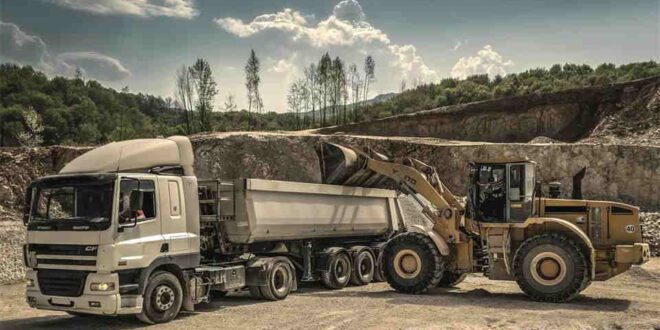Picture this: you’re driving down the highway when traffic suddenly comes to a complete stop. As you inch forward, you see the cause – a massive construction crane has broken down right in the middle of the road. The thing is enormous, probably weighs more than twenty regular cars combined, and it’s not going anywhere on its own.
This scenario happens more often than most people realize, and dealing with these giant machines when they fail creates challenges that are completely different from handling a regular car breakdown.
When Size Really Matters
Heavy machinery includes everything from bulldozers and excavators to massive cranes, cement mixers, and farming equipment. These machines can weigh anywhere from 10,000 pounds to over 100,000 pounds.
When a regular car breaks down, you might be able to push it to the side of the road or call a standard tow truck. But when a 50-ton excavator stops working in the middle of a construction site, that’s when things get complicated fast.
The weight alone creates problems that most people never think about. Regular tow trucks simply can’t handle this kind of load. The cables would snap, the truck would tip over, or worse, someone could get seriously hurt.
That’s why specialized Heavy-Duty Towing Experts use completely different equipment designed specifically for these massive machines. They have trucks with much stronger engines, reinforced frames, and special hydraulic systems that can safely lift and move equipment that weighs as much as a small building.
The Domino Effect of Equipment Failure
When heavy machinery breaks down, it rarely affects just one person. Construction projects can involve dozens of workers and millions of dollars worth of equipment.
If the main crane on a building site stops working, the entire project might have to shut down until it’s fixed or removed. Every day that equipment sits there not working costs money – sometimes thousands of dollars per day.
Farm equipment creates similar problems during crucial times like harvest season. When a massive combine harvester breaks down in the middle of a field during harvest time, farmers face a race against weather and time. Crops that aren’t harvested quickly enough can be ruined by rain or frost, potentially costing farmers their entire yearly income.
Road construction presents another set of challenges. When heavy equipment breaks down on active roadways, it creates traffic problems that can last for hours or even days. Emergency crews have to work around traffic while trying to clear massive machines that can’t simply be pushed out of the way.
The Complex Process of Moving Giants
Moving broken heavy machinery requires careful planning that starts long before any trucks arrive on scene. First, specialists need to assess exactly what they’re dealing with. They need to know the weight, dimensions, and condition of the equipment.
Is it completely dead, or can it still move under its own power? Are there hydraulic fluids leaking that could create environmental hazards? Is the machine stable, or could it tip over during the moving process?
Once they understand the situation, crews bring in specialized equipment. This might include heavy-duty flatbed trailers, powerful winches, hydraulic jacks, and cranes. Sometimes they need multiple trucks working together to handle one piece of equipment.
The process can take several hours, and it requires experienced operators who understand both the machinery being moved and the equipment doing the moving.
Safety becomes the top priority during these operations. Heavy machinery that’s already broken can be unpredictable. Hydraulic systems might fail suddenly, causing parts to drop or shift unexpectedly.
Crews use blocking, chains, and specialized tie-downs to secure everything before attempting to move it. They also need to consider things such as overhead power lines, bridge weight limits, and road width restrictions when planning the route to move the equipment.
Environmental and Legal Considerations
Heavy machinery often contains fluids that can harm the environment if they leak. Hydraulic fluid, engine oil, coolant, and fuel all need to be contained and cleaned up properly. When equipment breaks down, especially in sensitive areas such as near waterways or wetlands, environmental protection becomes just as important as clearing the equipment.
Legal requirements add another layer of complexity. Moving oversized loads on public roads requires special permits, escort vehicles, and sometimes police assistance. The timing of these moves is often restricted to certain hours or days of the week to minimize traffic disruption. All of this coordination takes time and adds to the cost of dealing with equipment failures.
Prevention and Preparation
Smart equipment owners don’t wait for breakdowns to happen. Regular maintenance helps prevent many failures, but it can’t eliminate them entirely. Heavy machinery works in harsh conditions – mud, dust, extreme temperatures, and constant vibration all take their toll on even the best-built equipment.
Many companies now use GPS tracking and diagnostic systems that can predict when equipment might fail. These systems monitor things such as engine temperature, hydraulic pressure, and operating hours to identify potential problems before they cause complete breakdowns.
The Real Heroes Behind the Scenes
The next time you see traffic backed up because of broken heavy equipment, remember that there are skilled professionals working to solve a complex puzzle. They’re dealing with machines that weigh more than most people can imagine, in conditions that are often dangerous and stressful.
Heavy machinery breakdowns will continue to happen as long as we rely on these powerful machines to build our roads, construct our buildings, and harvest our food.
Understanding what goes into handling these situations helps us appreciate the complexity involved and the skill required to keep our world running smoothly, even when the biggest machines decide to take an unscheduled break.
 khamush.com Lifestyle | Motivation | Poems
khamush.com Lifestyle | Motivation | Poems



